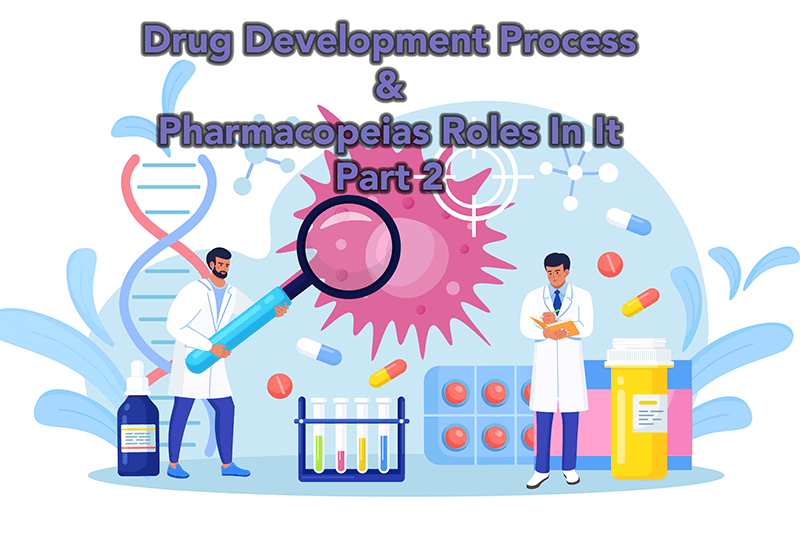The United States Pharmacopeia – National Formulary (USP-NF) is comprised of 6,800 monographs for over-the-counter and prescription products, medical devices, supplements, and other related particles and it is a resource for every step along the drug development process. There are four stages to drug development: R&D, regulatory review, manufacturing and distribution, and medication use. This article will cover the last two steps: manufacturing and distribution and end use, as well as how the USP-NF impacts these stages.
Medication Manufacturing and Distribution
The third step in the drug development process comes after FDA regulatory review and approval. At this point, manufacturers can actually start making, marketing, and distributing the new drug. The FDA does carefully evaluate these plans, especially manufacturing.
Manufacturing is where the rubber meets the road when it comes to regulatory compliance. The FDA frequently audits manufacturers for compliance under regulations such as GMP. This ensures the product’s strength, quality, and purity. This is a critical step in protecting the end user from contamination, something the USP-NF is specifically designed to help do.
Ensuring manufacturers are following their strict guidelines also confirms that batches will be identical and, thus, reliable for patients and the physicians prescribing them. These audits are why those of us in the industry are so strict when it comes to data integrity.
As clean air experts, this is our favorite part of the pharmaceutical industry. Drugs and medical devices are often manufactured, cleaned, and packaged in cleanrooms to maintain high levels of sterility. This manufacturing setting plays a large part in maintaining compliance as well as product integrity.
After the product is artfully and expertly manufactured in a cleanroom, it moves into distribution. There are a variety of options for this. Some manufacturers prefer to go through wholesalers, although rising costs and the accessibility granted by the internet has increased manufacturers ability to sell more directly to consumers.
Of course, patients and physicians have to gain awareness about new drugs somehow and this is often done through advertising. In 2021, companies spent an estimated $6.88 billion on direct-to-consumer advertising for pharmaceutical products. It is a large – and profitable – industry, which is one reason the FDA also carefully monitors this advertising.
This advertising goes beyond commercials with scrolling lists of side effects scrolling along the bottom of the screen and spouted off in the last four seconds of the ad with the speed and efficiency auctioneers would envy. It involves free samples, visiting physicians, sponsoring continuing education programs, and more.
How Do Pharmacopeias Impact Manufacturing and Distribution?
This is perhaps the stage in the drug development process where pharmacopeias play one of the largest roles. According to USP, they are “a strategic partner for industry and regulatory agencies in developing standards and associated analytical methods, insights and other solutions that help a manufacturer assess risk and detect impurity levels in a large range of therapeutic products approved in the US and globally. Regulators around the world rely on USP standards, including those for impurities, to assure quality in their products and manage risk in the drug approvals process and post-market surveillance.”
Manufacturing is where all the quality standards researched and developed by USP truly come into play.
Medication Use
After a drug has been dreamed off, engineered, tested, approved, manufactured, advertised, and distributed, it can finally do what it was meant to do: be used by a patient. There are four steps in the medication use mode: a clinician prescribes the medication (or, when appropriate, a patient self-prescribes a medication), a pharmacist prepares the medication, the patient consumers the medication, and, lastly, they are monitored for negative effects by a nurse, physician, themselves, or another persons.
When it comes to actual medication use, there are a number of stakeholders involved. The primary stakeholder is the patient and their families. They are most directly impacted by the medication’s efficacy and any negative side effects. But there are other stakeholders to consider during the manufacturing and production process, such as providers, payers (insurance companies), regulators, employers, manufacturers, distributors, and policy makers.
Every stakeholder has a unique perspective and interest in having a medication of high quality and efficacy. Patients and their family are seeking health and safety. Their employers also want their staff to stay healthy for their own reasons. Healthcare providers are vested in ensuring patient safety and meeting therapeutic objectives. Regulators are focused on public safety and health. Manufacturers are seeking to make new drugs to help people and feel voids, while also answering to their stockholders. And so the list goes on: every stakeholder has their own investment in the use of the medication.
How Do Pharmacopeias Impact Medication Use?
While it might appear that pharmacopeias have the least to do with medication use, that is both true and untrue. Yes, pharmacopeias have little to do with a medication being ingested, but the hard work, dedication, and standards set by the USP-NF in the US keep patients and prescribing physicians confident and secure in the medications they choose.
While most end-users might not even recognize the term “USP” or “pharmacopeia,” they reap the benefits of the dedicated physicians and experts working behind the scenes to ensure their safety.
Want To Stay In The Know?
The USP-NF is updated every year. While other regulations might not be updated as often, when they do change, it creates massive waves. If you want to ensure you are in the know about what is happening in industries that use cleanrooms, create a free account in our Knowledge Center.
We are clean air experts who are dedicated to sharing our knowledge with the world!


